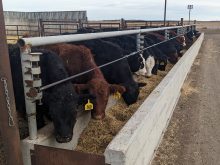It is axiomatic in the business world that the customer is king, everywhere but agriculture, that is. Agriculture’s approach to its customers in many cases is “take it or leave it.”
City people (and a growing number of farm families) worry that using pesticides leaves dangerous residues. They worry that eating animals given growth-promoting hormones may be harmful to humans. They worry that feedlot animals being given sub-clinical doses of antibiotics will create antibiotic resistance in bacteria that affect humans. (The Canadian Food Inspection Agency estimates about 30 percent of all livestock feed used in Canada contains medications.)
Read Also

Topsy-turvy precipitation this year challenges crop predictions
Rainfall can vary dramatically over a short distance. Precipitation maps can’t catch all the deviations, but they do provide a broad perspective.
Many city people don’t want to eat genetically modified organisms in their food. They are not convinced GMOs are safe.
Our response is to tell them they are wrong. Food is safe, we will keep doing what we are doing and they will just have to accept it.
Are they wrong and we right? Yes… partly.
Our food supply is generally safe. We have high standards of hygiene throughout the system and people in general are healthy. But they are also right in some of their worries.
Some pesticides used in the past have proven to be not as safe as we thought and have now been discontinued. Some of the pesticides we thought had been tested in the past weren’t thoroughly tested.
City folks also know that GMOs have been minimally tested for safe eating, due to a decision-making standard called “substantial equivalence,” meaning GMOs are about the same as traditional crops, so don’t need additional tests.
However, according to a Royal Society of Canada panel studying genetically modified foods a few years ago, what makes a new plant substantially equivalent is not clear. As well, the society argued that it is possible for one change in a gene to cause unexpected changes in the organism. As panel co-chair Conrad Brunk said, “You are not in a position to declare that something is (substantially equivalent, and therefore) safe unless you have looked for the potential problems and have evidence that it is safe.”
The society is a collection of scientists and academics from several fields of study.
Even when reputable scientists suggest GMOs may need further investigation, rather than the industry saying “gee , we’d better look into this,” we trash the reputation of the scientist who did the research, and pretend nothing is wrong.
Terje Traavik, scientific director of the GEN¯K-Norwegian Institute of Gene Ecology, and professor of Gene Ecology at the University of Tromso two years ago presented his institution’s preliminary research findings from three long-term studies of the safety of some GMO products at an international Biosafety Symposium in Kuala Lumpur. His institute’s research found some worrying issues, but for this disclosure he was criticized by GMO industry representatives, and had to defend his presentation in a subsequent paper.
He said he had presented his findings in the interests of the precautionary principle, which he says “emphasizes the importance of scientists taking responsibility for anticipation, acknowledgement and communication of uncertainty, in order to produce scientifically and socially robust knowledge.”
This ‘killing the messenger’ is self-defeating. Criticism of GMOs from other scientific circles (e.g. the Union of Concerned Scientists, the U.S. National Research Council) is growing. City people can read, they cruise the internet, and they are vitally interested in the safety of their food.
Food is an emotional, as well as physical, substance. Because it is so deeply personal and emotional, simply telling people not to worry about it is about as useful as giving safety statistics to people who are afraid of flying. Flying might be safer than driving but a person terrified of flying is still not going to get into an airplane.
I have heard scientists at agriculture conventions, in attempting to justify the use of pesticides, say, with straight faces, that some traditional food plants are also toxic. For example green spots on potatoes contain a toxin. This is a stupid argument, as we do not eat green potatoes, and even if we were dumb enough to do it, it is our choice. Consumers have no choice in whether there are pesticide residues in their foods, and they don’t like it.
It would be different if we needed every bit of the stuff we put into the food supply, but we don’t. I know enough people doing well feeding livestock without hormones or sub-clinical doses of antibiotics, or making good money farming organically to know organic farming can be every bit as productive and profitable as conventional.
And I have read many studies that agree. I know I am in contentious territory here, and for every study I quote, somebody else can find another one that refutes it. Nevertheless, more and more consumers are buying “natural” and organic food because they want to know it is safe.
According to a recent Agriculture Canada fact sheet, retail sales of organic foods have increased 20 percent per year over the past 10 years, with organic grain production being the fastest growing sector and by far the largest organic export commodity. Few other sectors in the entire Canadian economy can claim that kind of growth.
Maybe it’s time we started asking our customers “what would you like” instead of telling them “take it or leave it.”
Edmonton-based Noel McNaughton is a former broadcaster and rancher who lectures on farm lifestyle issues at agriculture conventions and for corporations. He can be reached at 780-432-5492, e-mail noel@midlife-men.com or visit www.midlife-men.com.














